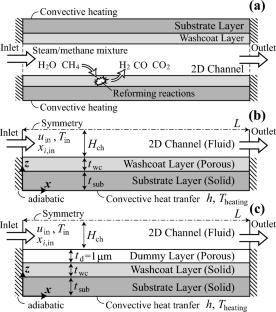Validation of Effectiveness Factor Correlations for Steam Methane Reforming in Ni-Based Washcoat Catalyst Layers Using Commercial Computational Fluid Dynamics Software
Abstract
In this study, the effectiveness factor correlations proposed for steam methane reforming (SMR) in Ni-based washcoat catalyst layers were numerically validated using the commercial computational fluid dynamics (CFD) software, ANSYS Fluent. The SMR process in an exemplary microchannel reformer was simulated, once by fully considering the reaction and diffusion process within the washcoat catalyst layer and again by simplifying the process calculation using the effectiveness factor correlations. It was shown that the proposed effectiveness factor correlations could successfully capture the SMR characteristics in the washcoat catalyst layer, with a discrepancy of approximately 0.1% point in the overall methane conversion ratio in the validation test, while reducing the calculation time by a factor of 1/5 for the same number of iterations. All these results clearly demonstrated that accurate and cost-effective CFD simulation of the steam reformer operation is possible using the proposed effectiveness factor correlations. Finally, this paper also addressed a possible numerical anomaly in the Fluent calculation identified during the present simulation.



 求助内容:
求助内容: 应助结果提醒方式:
应助结果提醒方式:


